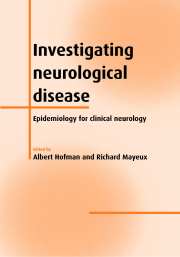Book contents
- Frontmatter
- Contents
- List of contributors
- Preface
- Part I Quantitative methods in clinical neurology
- Part II Neurological diseases
- 10 Cerebrovascular ischemic disease
- 11 Vascular dementia
- 12 Alzheimer's disease
- 13 Parkinson's disease
- 14 Multiple sclerosis
- 15 Myasthenia gravis
- 16 Guillain–Barré syndrome
- 17 Encephalitis and meningitis
- 18 HIV infection
- 19 Prion diseases
- 20 Neoplastic disease
- 21 Cerebral palsy
- 22 Migraine
- Index
19 - Prion diseases
from Part II - Neurological diseases
Published online by Cambridge University Press: 29 September 2009
- Frontmatter
- Contents
- List of contributors
- Preface
- Part I Quantitative methods in clinical neurology
- Part II Neurological diseases
- 10 Cerebrovascular ischemic disease
- 11 Vascular dementia
- 12 Alzheimer's disease
- 13 Parkinson's disease
- 14 Multiple sclerosis
- 15 Myasthenia gravis
- 16 Guillain–Barré syndrome
- 17 Encephalitis and meningitis
- 18 HIV infection
- 19 Prion diseases
- 20 Neoplastic disease
- 21 Cerebral palsy
- 22 Migraine
- Index
Summary
Introduction
Prion disorders form a group of transmissible spongiform encephalopathies that may afflict humans and other mammalians (1–3). They are transmissible within and between species by inoculation of infected tissue in the brain or administration to the blood, and, to a lesser extent, by ingestion of infected material. The most conspicuous feature at microscopic brain examination consists of spongiform changes due to cell loss. The clinical outcome of the encephalopathy consists mainly of dementia, behavioural changes, and cerebellar disorders. Human prion disorders include Creutzfeldt–Jakob disease (CJD), Gerstmann–Sträussler–Scheinker syndrome (GSS), fatal familial insomnia (FFI) and kuru. Prion disorders occur in inherited, acquired, and sporadic forms.
Despite their rare occurrence, the unique infectious and inheritable etiology of these dementias make them not only highly interesting scientifically but also important with regard to public health. The causative agent is thought to be a “prion,” which is an acronym for proteinaceous infectious particle. Unlike the “traditional” infectious agents such as bacteria and viruses, the prion contains little or no nucleic acid and shows an unusual resistance to traditional disinfectants, preservatives and ionizing radiation, which signifies its potential hazards. This resistance was dramatically illustrated by the outbreak of a bovine spongiform encephalopathy (BSE) epidemic in the UK during the 1980s, for which a change in decontamination procedure of ovine and bovine material for animal feeding was held responsible. In this chapter the etiology, diagnosis, occurrence, and prognosis of human prion disorders will be reviewed. The emphasis will be on CJD, by far the most common and complex prion disorder in humans.
Etiology
The pathogenesis of prion disorders remains an issue of ongoing debate.
Keywords
- Type
- Chapter
- Information
- Investigating Neurological DiseaseEpidemiology for Clinical Neurology, pp. 259 - 269Publisher: Cambridge University PressPrint publication year: 2001

